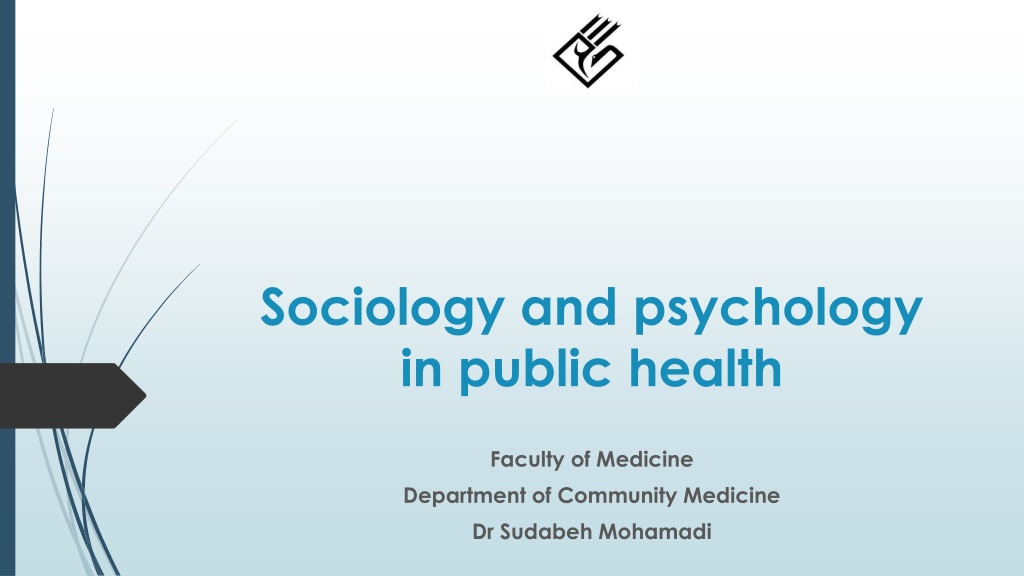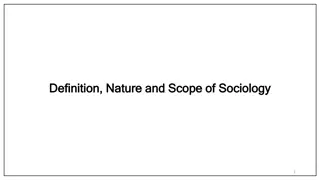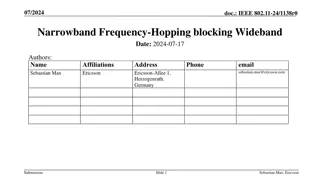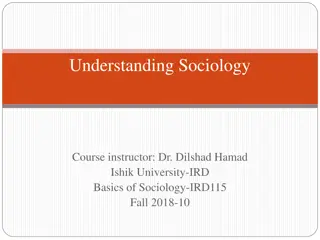Sociology and Psychology in Public Health: Exploring Common Links and Differences
Sociology and psychology intersect in public health studies, examining individual behavior and social structures. Commonalities include dedicated subfields for health and illness research, while differences lie in focus areas. Discover the impact of sociology in public health, historical contributions, and relevant theories such as structural-functionalism.
Download Presentation

Please find below an Image/Link to download the presentation.
The content on the website is provided AS IS for your information and personal use only. It may not be sold, licensed, or shared on other websites without obtaining consent from the author. Download presentation by click this link. If you encounter any issues during the download, it is possible that the publisher has removed the file from their server.
E N D
Presentation Transcript
Sociology and psychology in public health Faculty of Medicine Department of Community Medicine Dr Sudabeh Mohamadi
Introduction 3 Sociology and psychology have common links: Conceptually Methodologically
4 They differ in overall scope: Psychology typically focuses on the individual Sociology examines the individual s social action (agency) and the community s social and physical context (structure) within which they live, interact, work, and play.
5 Important similarity between sociology and psychology is that both disciplines have a dedicated subfield for the study of health and illness. These subfields are, respectively: Medical sociology Health psychology
Sociology in public health 6 The damage caused by epidemics alerted some British and authorities to the possible connection of three phenomena unrelated by medical experts: European medical hitherto seen as Social conditions in the community Social behavior Public health
7 Durkheim s conceptual contribution on the notions of the socially normal and abnormal set the path for twentieth century medical sociology .
8 Sociological theories may be classified into two types: General theories that address all human behaviour and applicability Middle-range theories that have limited applicability. have universal
9 The most relevant general theories for the sociological analysis of health and illness: Structural-functional theory Symbolic interactionism Conflict theory Phenomenology/ethnomethodology
Structural-functional theory 10 Neo-functionalism Addresses societies as social systems All components of society whether they are individuals, groups, nations, or global organizations, have functions both manifest and latent for their maintenance and growth communities,
11 Approaching the analysis of health-related phenomena from the structural-functionalist systems theory, we can offer two models of illness : The deviance model Sick-role or capacity model perspective of
12 The deviance model presents illness as a state of dependency for the person affected whereby therapy is expected but seen as a social control system and the physician as an agent of social control.
13 The capacity model proposes that illness is a breakdown of normality leading to the individual s total or partial incapacity to perform normal social roles.
Symbolic interactionism 14 The individual s subjective perception of the situation through meanings and symbols has a significant impact on his/her behaviour.
15 Two models of illness: The labelling model The negotiation or crisis model
16 The labelling model proposes that illness may be socially defined or labelled through a process evaluation. of normative
17 The patients have control over their illness through negotiation: Diagnoses and treatments by the medical profession may be treatment involves the patient s active participation. negotiation model proposes that negotiated and
Conflict theory 18 Proposes that the potential for conflict is a normal component of social relationships, thus, negotiation and bargaining are key elements of social interaction.
19 When applied to health phenomena, conflict theory offers two models: The loss or stress model The domination deprivation model
20 The loss or stress model proposes that there is a strong connection between stress and illness; the loss of required social support increases the likelihood of illness
21 The argues occupies a dominant position in society by virtue of its expertise vis-a-vis the patient s position of dependence. domination deprivation that the model medical profession
Phenomenology/ethnomethodology theory 22 People are the product of the very society they create . This phenomenology model regards illness as belonging to a broad category of disturbing occurrences. which breach the peace of everyday routines . taken-for-granted
23 Compared to the other theories, has contributed relatively less to empirical research in medical sociology.
Sociological research relevant to public health 24 The most significant social aspects that exemplify the link between individuals and groups in the context of public health are cultural and social class influences on health-related behaviour of individuals and communities; lifestyles; and the creation and transformation of healthcare systems.
Culture and public health 25 Culture refers to values and beliefs emanating from one s ethnic and/or religious ethos, typically transmitted across generations as part of the community s identity or design for living .
26 In addition to the influence of the physical and socioeconomic environment on the risk of infectious diseases and chronic illness, the impact of culture on public health is manifold and it is manifested in at least three main ways.
27 Health regarding health risks behavior: what people do Health attitudes and beliefs: how people feel and think about health and illness People s perceptions of and responses to health authorities public health guidelines and recommendations
28 Social stereotypes held by practitioners (whether clinicians practitioners) distort clinical decisions and interactions with their subjects of care and lead to linking certain diagnoses to certain patients . or public health
29 The impact of medical constructs , that is, when a physical or mental condition is defined by the health authorities as a disease while the same condition is considered normal by the community
30 When this clash of the expert versus lay interpretations occur, classification has consequences for the social legitimacy of the symptoms, access to treatment, and costs to the health care system the official
Lifestyle and health 31 Persistent differences in morbidity and mortality across ethnic groups that are basically of social rather than biological or genetic origin.
32 Lifestyles vary for men and women particularly in Asia. Gender differences are clearly discernible in morbidity and mortality figures.
33 A reinforced by his/her social network. person s lifestyle is shared and
34 Social ties and social networks significantly influence health-related leading to obesity, cigarette smoking, recreational drug use, and alcohol consumption, among other risk behaviours behaviour
35 The most visible influence of social networks on health is negative. Social networks can be mobilized in public health policy for the promotion of healthy habits and health risk-avoidance in the community.
Social class, social stratification, and public health 36 A person s social class socioeconomic status or SES is ascertained by means of a composite index of three or more indicators, the most common: Personal income level Years of formal education completed Occupational prestige
37 The simplest presentation of SES scores is a three-level description of lower class, middle class, and upper class. Quantitative and continuous SES scores are preferred in sociological studies.
38 Social class reinforces the influence of lifestyle on health behaviour.
39 Under certain conditions, social class mostly due to the influence of education and occupation may have a stronger impact than cultural beliefs and norms on health behaviour, on access to health services, and on a person s exposure to occupational hazards.
40 Sociologists examine the health impact of each SES component separately: Occupational prestige Income level Educational level The strength of SES as a predictor of health behaviour
The theory of fundamental causes states: 41 Social class influences multiple disease outcomes through multiple risk factors . Social class impacts access to resources that can be used to avoid risks or minimize the consequences of disease . Those influences tend to persist over time.
Healthcare systems and public health 42 When systems they include the approaches taken by nation-states creation, organization, distribution, and management of resources. sociologists study healthcare towards the their healthcare
43 In many countries today too much priority has been given to hospital care at the expense of the development of primary care, community care and public health .
44 Three types of studies illustrate the area of health services research:
45 The first type of study shows that unequal access to healthcare services is preserved by institutions and policies that constrain and enable the actions of health services organizations, health care providers, and consumers .
46 The second type of health systems research study is the comparative analysis of health financing approaches and systems in terms of their suitability to the socioeconomic needs and demographic characteristics of the population. Example: The study of insurance
47 The third type of study represents the direct input of medical sociologists on public policy. Example: analysis of changes in state regulations on the collection and access to health relevant population data for research purposes.
Sociological research methods and public health 48 Three sociological research methodology that must be taken into consideration: important characteristics of (1) The kinds of data used in sociology (2) The levels of measurement applied (3) The types of research design followed
What kinds of data are used in sociology? 49 Two kinds of evidence or data: Primary Secondary
50 Primary data: collected first-hand by the investigator Example: data on people s attitudes and behaviour obtained through personal interviews, observation, experiments, or surveys; or data extracted by means of first-hand analyses of documents, letters, records, or other types of raw data.





























